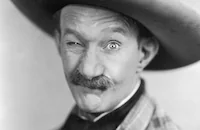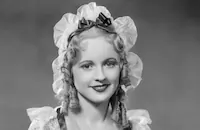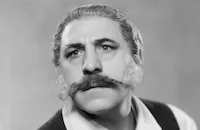The Devil's Brother

Brief Synopsis
Cast & Crew
Hal Roach
Dennis King
Thelma Todd
James Finlayson
Lucille Browne
Arthur Pierson
Film Details
Technical Specs

Synopsis
In the early 1700's, dreaded bandit Fra Diavolo returns to his camp in Northern Italy to tell his followers about his encounter with stodgy old Lord Rocberg and his lovely, silly young wife, Lady Pamela. Disguised as the Marquis de San Marco, Diavolo rode with them in their carriage and charmed Pamela into revealing the hiding place of her jewels. Diavolo now sends his thieves to rob the Rocbergs while, elsewhere, Stanlio and Ollio are also robbed of their life savings. Stanlio suggests that they become bandits too, but after they unsuccessfully try to rob a woodchopper, they run afoul of Diavolo, whom Ollio is impersonating. Diavolo is about to make Stanlio hang Ollio when he receives word that while his bandits did steal the jewels, they did not get the 500,000 francs hidden by Rocberg. Because he needs unknown assistants, Diavolo assumes his disguise as the marquis and takes Stanlio and Ollio into town with him, presenting them as his servants while he attempts to find the francs. Once at the inn where the Rocbergs are staying, Diavolo romances Pamela, while the boys, trying to turn in Diavolo for a reward, unwittingly capture Lord Rocberg, who is disguised as the marquis in an attempt to win back his wife. Diavolo terrorizes the boys into behaving, but when Stanlio accidentally drinks a sleeping potion meant for Rocberg, Diavolo's attempt to find the francs is foiled again. Diavolo does succeed in stealing Pamela's medallion, and the loss is blamed on young Captain Lorenzo. Lorenzo is the sweetheart of Zerlina, who is to marry a boring merchant named Francesco on orders of her father, Matteo the innkeeper. Although the wedding is scheduled to take place that day, Lorenzo swears he will prove his innocence before Zerlina is forced to marry Francesco. Meanhile, Diavolo continues romancing Pamela, and eventually finds out that Rocberg has hidden his fortune in her petticoat. Just as Diavolo steals the petticoat, Lorenzo finds out his true identity from Stanlio, who is "spiffed" after a visit to Matteo's wine cellar. Lorenzo has his soldiers surround the inn and he then duels with Diavolo, whom he bests with a little inadvertent help from Stanlio. The good-natured Diavolo returns the jewels, and when Rocberg will not pay the reward for them to Lorenzo, Diavolo gives Lorenzo the money that he stole from Pamela's petticoat. While the jealous husband rushes upstairs to confront his wife, Lorenzo gives the money to Matteo, thereby saving him from having to sell the inn. Diavolo, Stanlio and Ollio are then taken away to be shot by a firing squad, but when Stanlio takes out his red handkerchief with which to blindfold himself, a bull is enraged by the color and breaks up the ranks when he charges. Diavolo escapes on his horse, and Stanlio and Ollio wind up riding the bull to freedom.

Director

Hal Roach
Cast

Dennis King

Thelma Todd

James Finlayson

Lucille Browne

Arthur Pierson

Henry Armetta
Matt Mchugh
Lane Chandler
Nena Quartaro

Wilfred Lucas
James C. Morton

Stan Laurel

Oliver Hardy
Carl Harbaugh
Crew

Photo Collections
Film Details
Technical Specs

Articles
The Devil's Brother
Filmed prior to Sons of the Desert (1933), one of their most famous and enduring comedies, The Devil's Brother (1933), aka Fra Diavolo, Bogus Bandits, and The Virtuous Tramps, marks an interesting turning point in the early sound features of Laurel and Hardy. Despite years of perfecting their "act" in comedy shorts, the duo were still experimenting with the tone and style of their longer features and settled on an 1830 operetta by Daniel F. Auber as their musical film debut. It was a decision that made perfect sense as both Laurel and Hardy were quite accomplished song-and-dance men, having performed in various musical roles on stage and in vaudeville. But the real musical star of The Devil's Brother is Dennis King, whose famous baritone voice was heard in operas on both sides of the Atlantic in his day. As the much feared Fra Diavolo, King makes an ideal straight man for the duo, alternating between intimidation and self-mockery as he boasts about his exploits in song.
Laurel and Hardy both had misgivings at first that appearing in a period piece might be a cause for concern; their fans were used to seeing them in contemporary settings. Laurel also quarreled often with producer Hal Roach over the screenplay which was being adapted for the screen by Jeanie Macpherson (a frequent collaborator and mistress of Cecil B. DeMille). Luckily, co-star Thelma Todd was on hand to cheer Laurel up with her bawdy sense of humor and comic accounts of her off-screen love life.
When The Devil's Brother was finally released - after a sneak preview in which twenty minutes were reportedly cut - it proved to be their biggest box office hit and still holds that distinction today.
Despite the commercial success of the film, some moviegoers were divided over the film's mixture of comedy and music. Fans of the original operetta complained about the intrusion of what they felt were unnecessary slapstick interludes whereas some Laurel and Hardy fans felt the musical numbers, mostly performed by King, took up far too much screen time. A perfect example of the former opinion was voiced by Mordaunt Hall in his New York Times review: "Without being unkind to the apprehensive Stan Laurel or his companion, the ponderous Oliver Hardy; one is apt to conclude after witnessing this production that much less of their antics and more of Mr. King's fine baritone voice would have made this shadow version of an opera far more entertaining."
Quibbles aside, The Devil's Brother features some of Laurel and Hardy's best moments on the screen. From their ridiculous period wigs to Laurel's talent for butchering the simplest clichés ("You'd better watch your Qs and Ps," "Come easy, go easy"), the duo create memorable mayhem in scene after scene, the most famous being the wine drinking sequence in which both men become hysterical with laughter. Other routines from this film that you'll probably recall from your childhood are Laurel's maddening games of dexterity - "Earsie, Eyesie, Nosie" and "Finger-Wiggle" - and the famous final shot of the boys riding a wild bull out of town.
Producer: Hal Roach
Director: Hal Roach, Charles Rogers
Screenplay: Jeanie Macpherson
Cinematography: Hap Depew, Art Lloyd
Film Editing: Bert Jordan, William Terhune
Music: LeRoy Shield
Cast: Stan Laurel (Stanlio), Oliver Hardy (Olio), Dennis King (Fra Diavolo/Marquis de San Marco), Thelma Todd (Pamela Rocburg), James Finlayson (Lord Rocburg), Arthur Pierson (Lorenzo).
BW-91m. Closed captioning.
by Jeff Stafford

The Devil's Brother
Quotes
Trivia
In this movie, Laurel and Hardy are named respectively "Stanlio" and "Ollio". These are the names by which they are still known in Italy.
Notes
This film had its preview under the title Fra Diavolo, which was also the working title. In the onscreen cast credits, the actors' and actresses' names are written in the form of signatures, and "Stanlio's" signature is an X. Contemporary reviews incorrectly list Oliver Hardy's character as "Olivero," or "Oliverio." The New York Times review gives Hardy's character name as "Olivero Hardio" and Stan Laurel's as "Stanlio Laurelo." According to the VarB review of the film's preview at Santa Monica, CA on March 22, 1933, the picture ran 117 min. and was 11 reels long. According to modern sources, the film was re-issued as Bogus Bandits and The Virtuous Tramps. Modern sources add the following actors to the cast: George Miller (Village minister); Tiny Sandford (Tremulous woodchopper); Dick Gilbert, Jack Hill and Arthur Stone (Brigands); John Qualen (Owner of the bull); Harry Bernard (Imbiber at the Tavern, also a bandit); Rolfe Sedan, Kay Deslys, Leo White, Lillian Moore, Walter Shumway and Louise Carver (Tavern patrons); Marion Bardell (Tavern bartender); and Edith Fellows and Jackie Taylor (Frolicking village children). Among the many foreign versions of Fra Diavolo is the 1930 German-French-Italian co-production directed by Mario Bonnard and starring Tino Pattiera. The first American production of Fra Diavolo was a 1912 three-reel version directed by Alice Guy Blaché for Solax.















